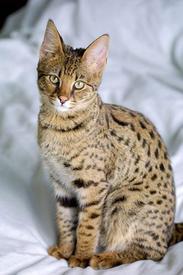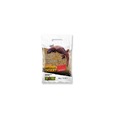
The first Savannah was developed in April, 1986 when Judee Frank, primarily a Bengal breeder, selectively crossed a domestic Siamese with a male serval (African wild cat). The resulting offspring possessed a very desirable look and pleasant temperament, leading to widespread interest in the new breed. One of the kittens was acquired by the breeder Patrick Keeley in 1989, with the intention of establishing a unique domestic breed that had never before been seen. Efforts were made to have the Savannah recognised as an independent breed, and in 2001 The International Cat Association officially registered it. The Savannah then gained championship status with TICA in 2012 and remains a rare and expensive breed today. It is considered a relatively modern cat that is still undergoing development.
Boasting a distinctly ‘wild’ appearance, the Savannah bears a striking resemblance to its serval forebear. Typically, a Savannah will display a lean and agile body frame, with long, slender legs and a relatively small head. Further characteristic features include hooded eyes, large, erect and deep ovular ears, a wide nose and a ringed tail with a solid black end. The hind legs are usually slightly longer than the front, giving a subtle sloping appearance. The Savannah is also characterised by its unique coat patterning, which varies depending on the domestic cat that is crossed with the serval. Tear-stain markings are common under the eyes, running parallel with the nose. The breed standard for TICA stipulates that only black spotted, black smoke, brown spotted tabby and silver spotted tabby are allowed. The Savannah is noted for its strong instincts to jump and climb.
These unique cats are often described as being more canine than feline. Possessing a huge capacity for love, loyalty and affection, a Savannah can usually be observed alongside its owner, or trying to participate in household activities, very similar to a dog. In this respect, Savannahs can be taught to fetch and can be leash trained. The Savannah is a highly active and inquisitive breed, and will require plenty of interactive toys and playthings to occupy its mind throughout the day. Breeders, owners and enthusiasts describe the cat’s ability to jump, as well as its fondness for water and its natural curiosity. Generally speaking, an adult Savannah can weigh up to 20 pounds, with males typically weighing more than females. The life expectancy is roughly 15 years.
Due to the rarity of the Savannah, determining any genetic or breed-specific health conditions is difficult. It is widely believed that the breed is both resilient and long-lived.








From Lincolnshire, United Kingdom
We are finding more and more HCM in the Savannah breed and so some of us breeders are now screening with cardiologists for HCM.
From West Yorkshire, United Kingdom
My Savannah is a big beautiful gentle boy. He is very affectionate and loving. He only plays if food is the reward! He is very quiet compared to the Siamese I was use too. He suffers from IBS so has to be on a grain free diet. This also means he has medication 4 times a day which he takes with no problem.
I absolutely adore him and would recommend the breed to anyone looking for a loving gentle cat.